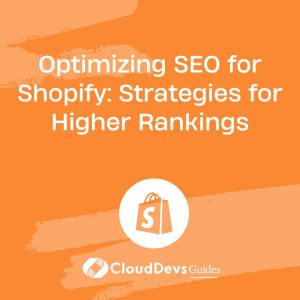Optimizing SEO for Shopify: Strategies for Higher Rankings
Search engine optimization (SEO) is crucial for the success of any online store, and Shopify is no exception. By implementing the right SEO strategies, you can significantly enhance your store’s visibility on search engines, attract more organic traffic, and ultimately increase sales. In this article, we’ll explore how you can optimize your Shopify store for higher rankings, providing practical tips and examples along the way.-
Understanding Shopify SEO
Shopify SEO involves optimizing your online store to rank higher on search engine result pages (SERPs). While Shopify provides some built-in SEO features, there are additional strategies and tweaks that can help you maximize your store’s visibility. Key areas of focus include on-page SEO, technical SEO, and off-page SEO.
1. On-Page SEO Optimization
On-page SEO refers to optimizing individual pages on your Shopify site to rank higher and earn more relevant traffic. This includes keyword optimization, meta tags, content quality, and more.
Keyword Research
Start by identifying the right keywords for your products. Use tools like Google Keyword Planner or Ahrefs to find keywords with high search volume and low competition. Once you have a list, strategically place these keywords in your product titles, descriptions, meta tags, and headings.
Optimizing Product Pages
Each product page should be optimized with the target keywords. Here’s how:
- Product Titles: Include the main keyword and make it descriptive.
- Meta Descriptions: Write compelling meta descriptions that include keywords and encourage clicks.
- Product Descriptions: Craft unique and detailed product descriptions that naturally incorporate your target keywords.
- Image Alt Text: Add descriptive alt text to all images, using relevant keywords where appropriate.
Example: Optimizing a Product Page
```html <h1>Organic Cotton T-Shirt – Eco-Friendly and Comfortable</h1> <p>Our <strong>Organic Cotton T-Shirt</strong> is the perfect blend of style and sustainability. Made from 100% organic cotton, this t-shirt is soft, breathable, and eco-friendly. Available in various colors and sizes. Order now to experience the comfort of organic cotton!</p> ```
2. Technical SEO for Shopify
Technical SEO ensures that your Shopify store is easily crawlable and indexable by search engines. This involves optimizing site speed, mobile-friendliness, and site structure.
Improving Site Speed
Site speed is a critical ranking factor. Shopify stores can sometimes be slow due to large images or unoptimized themes. Here’s how to improve it:
- Image Optimization: Compress images without losing quality. Tools like TinyPNG or ImageOptim can help.
- Theme Optimization: Choose a fast-loading theme and minimize the use of heavy scripts and apps.
Example: Using Lazy Loading for Images
Implement lazy loading to defer offscreen images from loading until the user scrolls to them. This reduces initial page load time.
```html <img class="lazyload" data-src="product.jpg" alt="Organic Cotton T-Shirt"> ```
Mobile Optimization
With a significant portion of traffic coming from mobile devices, ensuring your Shopify store is mobile-friendly is crucial. Use Shopify’s responsive themes and test your site on various devices to ensure a seamless experience.
3. Off-Page SEO Strategies
Off-page SEO involves activities outside your website that impact your rankings. This includes link building, social media marketing, and influencer collaborations.
Building Backlinks
Backlinks from reputable websites signal to search engines that your Shopify store is trustworthy and authoritative. Strategies for building backlinks include:
- Guest Blogging: Write guest posts for relevant blogs in your niche.
- Partnering with Influencers: Collaborate with influencers to review your products and link back to your store.
- Content Marketing: Create valuable content that others want to link to, such as blog posts, infographics, or case studies.
Example: Writing a Guest Post
If you sell eco-friendly products, write a guest post about sustainable fashion on a popular eco-lifestyle blog and include a link back to your Shopify store.
4. Utilizing Shopify Apps for SEO
Shopify offers a variety of apps that can help you enhance your SEO efforts. Some popular options include:
- SEO Manager: Provides tools to optimize your Shopify store’s on-page SEO.
- Image Optimizer: Automatically compresses images to improve site speed.
- Plug in SEO: Analyzes your site for SEO issues and provides actionable recommendations.
Example: Installing an SEO App
Install the SEO Manager app to monitor and improve your Shopify store’s SEO. It allows you to edit meta tags, create redirects, and fix broken links directly from the Shopify dashboard.
Conclusion
Optimizing your Shopify store for SEO is an ongoing process that requires consistent effort. By focusing on on-page, technical, and off-page SEO, you can significantly improve your store’s visibility and attract more organic traffic. Remember to utilize Shopify’s built-in features and third-party apps to support your SEO strategy. With these tips, your Shopify store will be well on its way to achieving higher rankings and increased sales.
Further Reading:
Table of Contents









